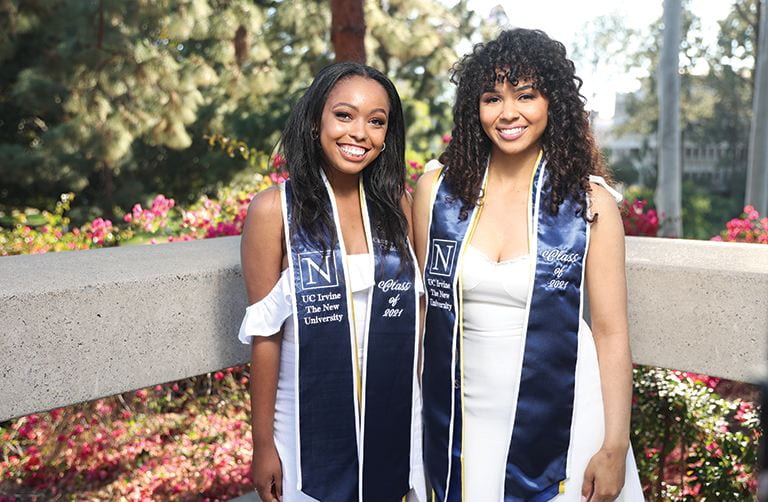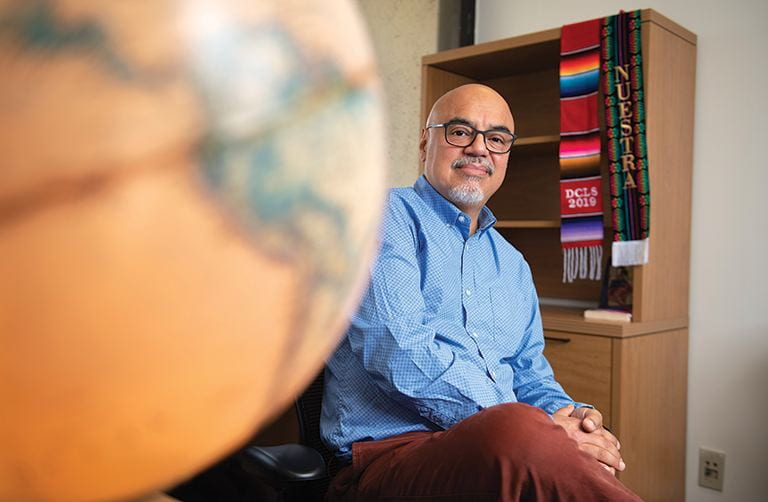Building Solidarity With Communities
UCI researchers across campus take an inclusive, collaborative approach to working in local areas
Originally published in fall 2021 issue of UCI Magazine
For many years, “parachute research” was the modus operandi for many academics. Drop into an area, extract data and help from community members, and then leave without providing them any benefit from the insights and advances they made possible.
The glaring and growing holes in that model – namely, the social, economic and racial disparities it perpetuates – have grounded parachute research in favor of a more collaborative approach to engaging with communities, especially communities of color.
“There have been broader conversations at universities around the country about how to be more impactful for society,” says June Ahn, UCI associate professor of education.
He is one of numerous researchers across the UCI campus, from arts to law to ecology and beyond, who are closely collaborating with local partners to jointly identify their needs and develop equitable, respectful and inclusive solutions that benefit the greater community. A few of their efforts are highlighted on the following pages.
Newkirk Center for Science & Society │ Research Justice Shop

If it’s broken, fix it.
Established in 2018, the Research Justice Shop aims to reshape the way scholars engage with the groups they study. “A lot of people see university researchers coming into their community and think, ‘They’re not here for the long run,’” says Victoria Lowerson Bredow, the RJS’s co-director and the Newkirk Center for Science & Society’s director of engaged scholarship. “Yet often the data is coming from them. It’s the water coming out of their faucets, the soil in their neighborhood, even the blood from their bodies, that’s being used for research.”
Representing disciplines as disparate as drama and public health, the 10 graduate Newkirk Fellows working through the RJS meet with residents and local organizers to tackle issues predominantly affecting underserved neighborhoods – including water pollution, air quality and COVID-19.
“It’s not just how to collaborate with communities,” says Connie McGuire, the RJS’s co-director and the Newkirk Center’s director of community relationships, “but how to work in solidarity with communities that are experiencing the brunt of our social and environmental problems and working on their own behalf to solve those challenges.”
One such RJS collaboration is the Communities Organizing for Better Water PhotoVoice project. Two Newkirk Fellows work with volunteers in central Orange County who have been documenting local water pollution for more than a year. Photos of residents boiling their brownish tap water before drinking it and stagnant puddles of polluted runoff showcase a dim reality invisible to their more affluent neighbors.
“It’s so easy to settle into doing research about people instead of with people,” says Ethan Rubin, a UCI doctoral student in education and one of the Newkirk Fellows working on the PhotoVoice project. “But I don’t think that benefits our research or the communities we’re supposed to be helping.”
With training from the RJS, UCI researchers add value to community organizations right off the bat, according to Patricia Flores, project director at Orange County Environmental Justice, which runs the PhotoVoice initiative. “The Research Justice Shop provides crucial support,” she says. “Their students come to our projects with a grassroots perspective, ready to work with our organization.”
Claire Trevor School of the Arts │ Creative Connections

When UCI drama students Luciana Valero and Meghan Minguez-Marshall arrived at Santa Ana High School for their Creative Connections internship in spring 2021, “they brought an energy and enthusiasm that was much needed in a difficult school year,” says Terry Schwinge, visual and performing arts coordinator at the school.
Creative Connections is a teaching artist internship program that each year sends 15 to 30 UCI arts majors into K-12 classrooms to partner with an educator to develop and implement lesson plans. Past interns have coached musical ensembles, assisted with play productions, taught line drawing themed around Egyptian history, even choreographed a dance to represent states of matter.
“We don’t go in with preconceived notions about what that community or teacher needs,” says Megan Belmonte, director of outreach programs for UCI’s Claire Trevor School of Arts. “It begins with a discussion about ‘What gaps are there? What are the strengths of our interns? What can they bring to the table to help fill some of those gaps?’”
The proposal by Valero and Minguez-Marshall – then a junior and a senior, respectively – to teach Schwinge’s students how to write monologues dovetailed perfectly with interest from the South Coast Repertory theater company in having Santa Ana High School students create original works reflecting their community and their own lives.
“Having students from a lower economic background, as is the case with many families in my community, guest speakers and visiting instructors often mistakenly bring low expectations,” Schwinge says. “From the start, Lucy and Meghan respected my students completely and had a keen sense of how to reach and inspire them.”
The resulting work, “Rising Spirits: First Draft,” was written by Santa Ana High School students, performed by UCI’s Brown Bag Theater Company and aired on South Coast Repertory’s social media channels. It featured a diverse range of monologues, some completely in Spanish, that shared the students’ family histories, reflections on social justice issues and the struggles that come with growing up Latino.
“I think the final production truly reflected who the students are,” Valero says, “and what their community – and ours – ultimately looks like.”
School of Law | Orange County Domestic Violence Death Review Team
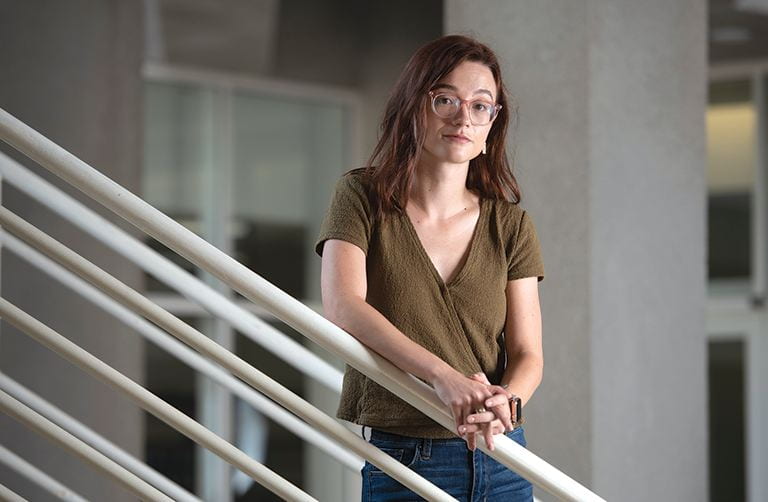
Third-year law student Amy Abshier has found her legal calling by volunteering in the Domestic Violence Clinic at UCI’s School of Law. In addition to providing direct legal representation for survivors, Abshier is speaking for victims who can no longer speak for themselves through her work on the Orange County Domestic Violence Death Review Team.
For the past five years, UCI law students have participated on this collaborative, interagency group under the guidance of its co-chair, Jane Stoever, clinical professor of law and director of the school’s Domestic Violence Clinic. The team collects and analyzes data from domestic violence fatality cases in Orange County to look for trends and overlooked intervention points. “Our work is done with an eye on abuse prevention and fatality prevention in terms of how our county systems, courts and community resources can better coordinate and provide what’s needed for more effective and helpful interventions,” Stoever explains.
Abshier was among three UCI law students who pored over a decade of case narratives – 113 cases in all – to compile a master report that will be released this fall. “We want people to know the severity and prevalence of domestic violence, even here in Orange County, which is generally thought of as a safe area,” she says.
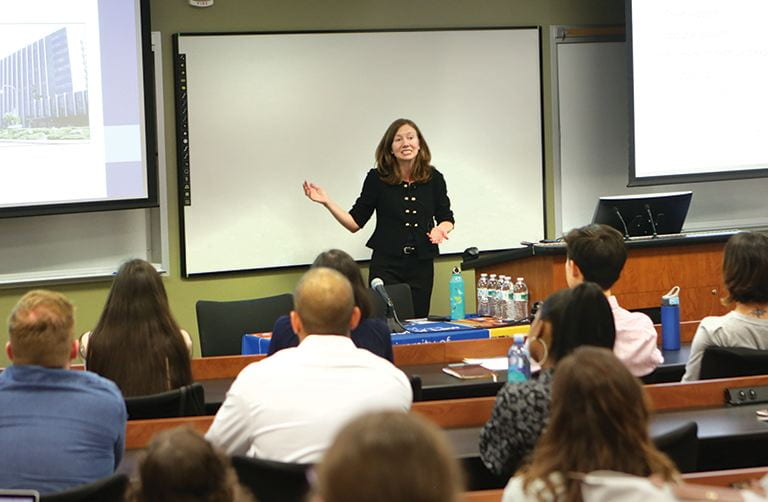
Among the team’s key findings: 72 percent of case fatalities involved firearms. “The combination of domestic violence and firearms in the home increases fatality risks by 500 percent,” Stoever says. “California has laws concerning domestic violence and firearm prohibitions, and we need to ensure we don’t have an implementation gap in how those laws are carried out.”
Abshier was struck by how often opportunities were missed to interrupt the cycle the violence. “As heavy as it may be to review these cases,” she says, “it can help shed light on the ways we can prevent domestic violence fatalities in the future.”
Humanities Center | Stories From the Sea
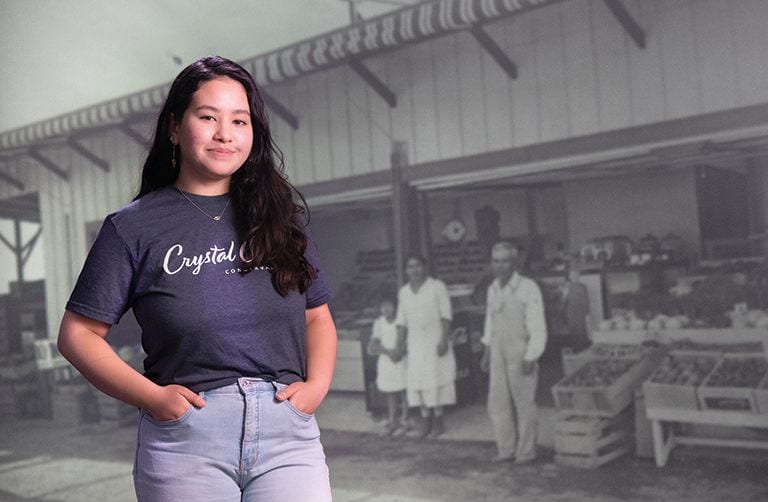
“The sea, once it casts its spell, holds one in its net of wonder forever.” That quote from Jacques Cousteau captures the inspiration and anchors the website of the Stories From the Sea initiative, a collaboration between the UCI Humanities Center and the Newport Beach Public Library Foundation, as well as the UCI Center for Storytelling, UCI Libraries and the UCI Department of History.
A yearlong internship – part of the Humanities Center’s focus in 2020-21 on the theme of oceans – trained UCI students from across numerous degree programs to conduct oral history interviews, digitize photos and other memorabilia, and produce stories through mixed-media methods such as podcasting to preserve important memories of encounters with the sea.
“Focusing on oceans offers opportunities to both tackle big issues of our society and provide insight into everyday, intimate interactions and feelings,” says Judy Tzu-Chun Wu, director of the UCI Humanities Center. “[It] can bring us together across research disciplines and across communities.”
The students interviewed such fascinating and diverse subjects as the staff of the Pacific Marine Mammal Center, the owners of Seaside Donuts Bakery and the founder of Courage Camps, a nonprofit surfing network for Latina girls.
“We managed to connect the community elders with students and capture firsthand accounts of the rich local coastal history,” says Kunga Wangmo-Upshaw, director of programs for the Newport Beach Public Library Foundation. “These stories are now part of the local history collection and can be found in UCI Libraries’ archives, which are accessible to all.”
For Rehana Morita, a UCI junior in Asian American studies and film & media studies, the internship was the perfect opportunity to combine her two areas of interest into one community-based project. She combed through the archives of the Crystal Cove Conservancy to create a photo essay titled “Crystal Cove’s Untold History of Japanese American Farmers.”
“With the rise of anti-Asian hate this past year, I wanted to find a way to give back to my community,” Morita explains. “As a Japanese American myself, I wanted to learn more about the community’s history, especially because in Orange County the history we know is mostly about white communities and not about communities of color.”
The conservancy was so impressed with Morita that it hired her as a summer intern to expand her photo essay into a virtual history tour for the conservancy’s website. “It was so rewarding to dig deeper into the history of these families,” Morita says, “and learn not only about their day-to-day life but about how their experiences of facing racism and xenophobia 80 to 100 years ago are reflective of the world we live in today.”
School of Education | Orange County Educational Advancement Network
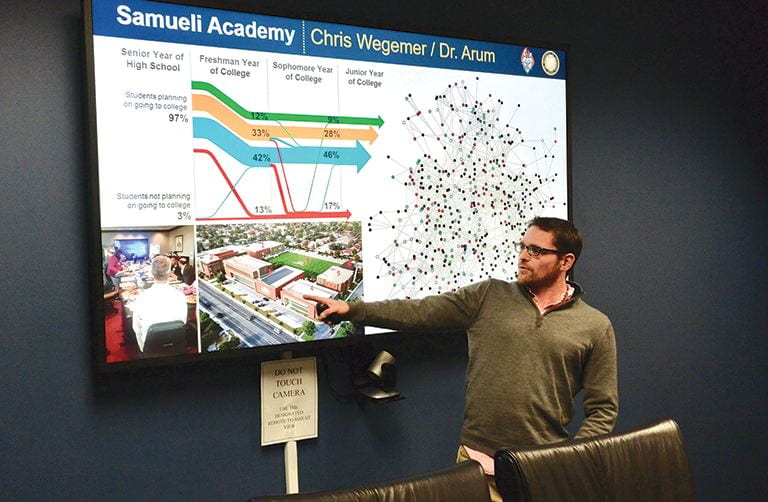
OCEAN matches a UCI School of Education faculty member and doctoral student with an Orange County K-12 school. The pair works with school leadership to identify the most urgent needs and goals and then conducts research that informs a plan of action for the school’s priorities. Staff from the partner schools then gather to address shared problems and simultaneously implement effective resolutions across what’s called a Networked Improvement Community.
“All of our partners are really enthusiastic and hungry to leverage the resources of our research university for their local projects,” says June Ahn, OCEAN’s founding director and a UCI associate professor of education. Their enthusiasm has been contagious: Over the past three years, OCEAN has grown from six to 25 partnerships.
At Samueli Academy, a high school in Santa Ana, doctoral candidate Chris Wegemer has conducted surveys and crunched the data on subjects ranging from student comfort with COVID-19 policies to a gender gap in science, technology, engineering and math class participation.
The findings prompted the academy to adopt a “Women in STEM” initiative, which included hiring a female STEM teacher and increasing recruitment of female students for engineering classes.
“Education research often feels disconnected from real impacts or applications,” Wegemer says. “This work is connected to actual policies and practices.”
The OCEAN partnership with Samueli Academy, which has a large enrollment of students who are in the foster care system, inspired the creation of a Networked Improvement Comm unity focused on enhancing communication, cooperation and coordination among schools and community agencies that serve the needs of foster children. “That’s been a nice progression of starting with a partner, working from their needs and their expertise, and then building out bigger projects,” Ahn says.
“Samueli Academy is proud to be part of the OCEAN initiative,” says Anthony Saba, the school’s executive director. “This collaboration will not only help us better serve our students, but also be a resource to organizations everywhere that are trying to make a difference in the lives of youth.”
School of Biological Sciences | UCI/OC Parks/Irvine Ranch Conservancy Loma Ridge Partnership

Steve Zylius / UCI
The longtime collaboration at Loma Ridge among UCI scientists, the Irvine Ranch Conservancy and OC Parks has produced numerous benefits over the years for all three partners. For the conservancy, which manages Loma Ridge among its roughly 50,000 acres in Orange County, UCI’s research capacity and focus on answering foundational scientific questions produce knowledge that informs its land management decisions. UCI gains access to an enormous, well-tended outdoor laboratory. And OC Parks, which owns Loma Ridge and the land around it, gets restored habitats within its nature preserves.
At any given time, 15 to 20 UCI students, postdoctoral researchers and staff are working on experiments related to Loma Ridge. Someone from UCI is at the site almost every day, especially in springtime. Data is continually collected on temperature fluctuations; wind patterns; types of plants; the levels of pH, carbon and nitrogen in the soil; and other things. Dozens of scientific studies have been published based on experiments at Loma Ridge looking at topics such as how microbe diversity relates to plant diversity and how ecosystems recover after fires.
Steven Allison, UCI professor of ecology & evolutionary biology, is conducting a study funded by a $2.7 million grant from the U.S. Department of Energy to see how soil microbes at Loma Ridge respond to drought. “We work closely with the Irvine Ranch Conservancy,” he says, “and share our results with them to see if we can make these systems more resilient to climate change, more resilient to fire, and if there’s a way we can manage for endangered species or for pollution.”
Christine Byrd and Aaron Orlowski contributed to this article.


